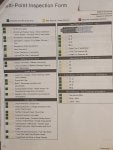Since this post has turned at some level into a discussion about alignment, I’ll add my two cents. There is really only a few reasons for an alignment. The first is AFTER repairs have been made to the vehicle that now allows for an alignment to correct for replaced parts which were throwing the alignment off to begin with(the damaged parts and then the replacement parts). The second reason is if the alignment was off from the factory. Yes, this can happen. So, overall, an alignment is required after damage to a front end occurs and the damaged parts are replaced. Only then is an alignment required. If you do an alignment after front end damage and no parts replacement, the alignment will not hold as damaged parts will continue to change such that the alignment will not hold, so you’re wasting your money. The same holds for worn parts. So, to be clear, an alignment will correct for worn parts, BUT the parts will continue to wear and the alignment will not hold. An alignment can sometimes correct for damaged parts BUT the parts are still damaged and I sure as hell wouldn’t drive a vehicle with damaged steering / suspension parts as they could fail at anytime. Two other points, first, in some rare cases new rims where wheel offset changes may require adjustments to alignment to correct for the new wheel offsets. The other point? Is very important, and is likely the cause for many non required alignment adjustments. Anytime you are having your alignment checked PRIOR to the check or even more important prior to the alignment (due to parts / damage being fixed) make absolutely sure your tire pressure is set exactly as specified on your drivers side door frame(and that the tire have even tread wear across all 4 tires, the tires should be a matched set). I’ve seen many incorrect adjustments to alignment made when tire pressure isn’t correct / balanced (different tires / bad tire wear, etc). Yes, incorrect tire pressure can throw off your alignment / and the way your vehicle tracks. So, to summarize, alignment checks are fine as long as who ever is doing them knows what they are doing, their equipment is set up correctly and is calibrated. If you don’t know this for sure then the alignment check is best skipped and alignments are truly only needed to correct for worn out or damaged parts that have been replaced.





